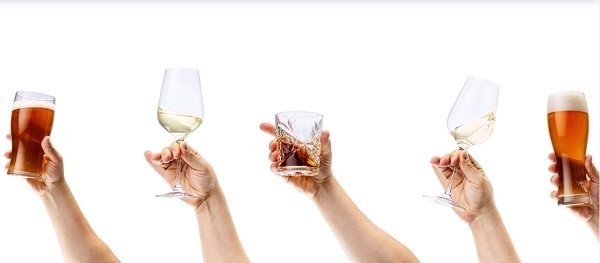Statistics Canada would like to know how much you’ve been drinking.
In October, the federal statistical agency released “A snapshot of alcohol consumption levels in Canada” based on its large-scale 2023 Canadian Community Health Survey that asked Canadians how much they drank in the previous week. The topline number: more than half of those surveyed – 54.4 percent – said they didn’t touch a drop in the past seven days. This is considered “no risk” according to the Canadian Centre on Substance Abuse and Addiction’s (CCSA) 2023 report Canada’s Guidance on Alcohol and Health, which Statcan uses as its standard. Among those who did imbibe, 15.2 percent said they’d had one or two drinks in the last week, an amount the CCSA guidance considers “low risk”, 15.2 percent said they’d consumed between three and six drinks, considered by CCSA to be “moderate risk”, and the remaining 15.1 percent admitted to seven or more drinks per week, what the CCSA calls “increasingly high risk”.
Statcan then sliced this information several different ways. By gender, men reported being bigger drinkers than women, based on their relative share in the “high risk” category (19.3 percent versus 11.1 percent). By age, the biggest drinkers are those 55-64 years, with 17.4 percent consuming at least one drink per day. Perhaps surprisingly, the 18-22-year-old college-aged group reported the lowest level of “high risk” drinking across all ages, at 8.4 percent, an outcome consistent with other observations that younger generations are becoming more conservative.

Statcan’s data also reveals that Quebeckers are the biggest drinkers in the country with 18.1 percent in the “high risk” category, while Saskatchewan and New Brunswick had the greatest number of teetotalers. Rural residents are bigger drinkers than those living in urban areas. By occupation, those holding male-dominated jobs in the trades, equipment operation and transportation were the most likely to report drinking in the “high risk” category of seven or more per week. Finally, the richest Canadians – those in the top income quintile – said they drink more than Canadians in lower income quintiles, an outcome that seems logical given the cost of a bottle these days.
The demographic detail in Statcan’s alcohol consumption survey is extensive and largely in keeping with general stereotypes. The quintessential drinker appears to be a middle-aged blue-collar male living in rural Quebec. (Although the report notes an enormous discrepancy between self-reported consumption data and national alcohol sales, with self-reported amounts accounting for a mere one-third of actual product sold. This suggests many Canadians are far from truthful when describing how much they drink.)
Despite the apparent surfeit of information, however, several demographic categories are missing from Statistics Canada’s report. And not by accident. According to a “Note to readers” at the bottom of the October report, the survey “included a strategic oversample to improve coverage…for racialized groups, Indigenous people, and persons with disabilities. While this analysis does not contain results for these populations (primarily owing to the need to delve into historical/cultural or other contexts for these groups as it pertains to alcohol consumption), the Canadian Community Health Survey 2023 data is now available to aid researchers looking into health analysis for these populations.”
The demographic detail in Statcan’s alcohol consumption survey is extensive and largely in keeping with general stereotypes. The quintessential drinker appears to be a middle-aged blue-collar male living in rural Quebec.
The upshot of this word salad: Statcan went to extra lengths to get high-quality information on the alcohol consumption of natives, visible minorities, immigrants and people with disabilities. And then it enshrouded these numbers in a cloak of secrecy, choosing not to release that information publicly because of “historical/cultural or other contexts”. Why is Canada’s statistical agency keeping some of its data hidden?
Canada’s Guidance on Alcohol and Health
Before investigating the missing data, it is necessary to discuss a controversy regarding the alcohol consumption guidelines used by Statcan. As mentioned earlier, its survey is based on new CCSA standards released last year which consider seven or more drinks per week to be “increasingly high risk”. This is the result of recent CCSA research that claims “even a small amount of alcohol can be damaging to health.” By focusing on the incidence of several obscure cancers and other diseases associated with alcohol consumption, the CCSA recommends that Canadians cut back drastically on their drinking. For those who wish to be in the “low risk” group, the CCSA recommends no more than two drinks per week for men and women, and not downing both on the same day.
 To your health: The “J-Curve” plots the well-documented relationship between moderate social drinking and a long lifespan, revealing the healthiest level to be around one drink per day, what the new CCSA standards call “high risk”.
To your health: The “J-Curve” plots the well-documented relationship between moderate social drinking and a long lifespan, revealing the healthiest level to be around one drink per day, what the new CCSA standards call “high risk”.
Such a parsimonious attitude towards drinking is at sharp odds with earlier CCSA findings. In 2011, the CCSA released “Canada’s Low Risk Alcohol Guidelines”, which defined “low risk” drinking levels very differently. Under this older standard, Canadians were advised to limit their consumption to 15 drinks per week (10 for women) and no more than three per day. It also acknowledged that it was okay to indulge on special occasions, such as birthdays or New Year’s Eve, without fear of any long-term health effects.
These rules were based on ample medical evidence pointing to substantial health benefits arising from moderate drinking, given that social drinkers tend to live longer than both abstainers and alcoholics – a statistical result that, when placed on a graph, yields what is commonly referred to as the “J-Curve”. These rules also aligned with social norms and hence garnered broad public support.
The dramatic contrast between the 2011 and 2023 CCSA drinking guidelines has attracted strong criticism from many health experts. Dan Malleck is chair of the Department of Health Sciences at Brock University in St. Catharines, Ontario, as well as director of the school’s Centre for Canadian Studies. In an interview, he bluntly calls the new CCSA guidelines “not useful, except as an example of public health over-reach.” Malleck argues the emphasis CCSA now places on the tiny risk of certain cancers associated with alcohol ignores the vast amount of evidence proving moderate drinking confers both physical and social advantages. This, he says, does a disservice to Canadians.
 “The opposite of good public health advice”: According to Dan Malleck, chair of Brock University’s Department of Health Sciences, the Canadian Centre on Substance Abuse and Addiction’s (CCSA) 2023 guidelines suggesting alcohol in any amount is a health hazard are unrealistic. (Source of photo: Brock University)
“The opposite of good public health advice”: According to Dan Malleck, chair of Brock University’s Department of Health Sciences, the Canadian Centre on Substance Abuse and Addiction’s (CCSA) 2023 guidelines suggesting alcohol in any amount is a health hazard are unrealistic. (Source of photo: Brock University)
“The Opposite of Good Public Health Advice”
“There are two possible responses” to the CCSA’s new drinking guidelines touting near-abstinence as the preferred course of action, Malleck says. “People will hear the message that no amount of drinking is healthy and simply ignore the recommendations altogether because they’re so restrictive – and so we end up with no effective guidance. Or they’ll take it all at face value and become fearful that having just two beers a week will give them cancer. Creating that sort of anxiety isn’t useful either.” Considering the two alternatives, Malleck says the end result “is the opposite of good public health advice.”
Perhaps surprisingly, it appears Ottawa agrees with this assessment. While the CCSA is a federally-funded research organization, it is not a branch of the civil service. As such, its work does not automatically come with an official imprimatur. Rather, its reports have to be adopted by Health Canada or another department to become government policy. This was the case with its 2011 guidance. It is not the case with CCSA’s new report.
In response to a query from C2C, Yuval Daniel, director of communications for Ya’ara Saks, the federal minister of Mental Health and Addictions, stated that, “The Canadian Centre for Substance Abuse and Addiction’s proposed guidelines have not been adopted by the Government of Canada. Canada’s 2011 low-risk alcohol drinking guidelines remain the official guidance.”
 Too strict even for the Liberals: Federal Mental Health and Addictions Minister Ya’ara Saks has chosen not to adopt the CCSA’s 2023 drinking guidelines as official policy – yet Statistics Canada insists on using them to measure Canadians’ drinking habits. (Source of photo: The Canadian Press/Adrian Wyld)
Too strict even for the Liberals: Federal Mental Health and Addictions Minister Ya’ara Saks has chosen not to adopt the CCSA’s 2023 drinking guidelines as official policy – yet Statistics Canada insists on using them to measure Canadians’ drinking habits. (Source of photo: The Canadian Press/Adrian Wyld)
It seems the CCSA’s new and abstemious drinking guidelines are too strict even for the federal Liberals. The 2011 standard, which considers anything up to 15 drinks per week to be “low risk”, remains the government’s official advice to Canadians. While this seems like a small victory for common sense, it raises another question: if the federal government has refused to adopt the strict 2023 CCSA drinking standards, why is Statcan using them in its research?
According to Malleck, the appearance of the new, unofficial CCSA alcohol guidance in Statcan’s work “legitimizes” the explicitly-unapproved guidelines. “It further reinforces these seemingly authoritative, government-funded recommendations” and obscures the sensible, official advice contained in the earlier guidelines, he says. It seems a strange state of affairs. But given other odd aspects of Statcan’s alcohol survey, it is in keeping with an emerging pattern of problematic behaviour at the statistical agency. Statcan is no longer merely gathering information and presenting it in an objective way, to be applied as its users see fit; the agency appears to be crafting its own public policy by stealth.
Uncovering the Missing Data
Recall that Statcan’s recent alcohol survey withheld consumption data regarding racial, Indigenous and disabled status for reasons of “historical/cultural or other contexts”. Although the statistical agency collected the relevant numbers, it then restricted access to researchers “looking into health analysis for these populations.” As a media organization, C2C requested this data on the grounds it was public information. After some back-and-forth that included the threat of a $95-per-hour charge to assemble the figures, Statcan eventually provided the once-redacted numbers for free. With the data in hand, it seems obvious which numbers were withheld and why.
The only category that seems worthy of any comment is that of Indigenous Canadians. At 20.1 percent, aboriginals display one of the highest shares of ‘high risk’ drinkers in the country.
Nothing about alcohol consumption by immigrant status or race appears newsworthy. Immigrants are revealed to be very modest drinkers, with 68 percent reporting no alcohol consumed in the past week, and only 7 percent admitting to being in the “high risk” seven-drinks-per-week category. Similar results hold for race; Arab and Filipino populations, for example, display extremely high rates of abstinence, at 88 percent and 80 percent, respectively. Disabled Canadians are also very modest drinkers.
The only category that seems worthy of any comment is that of Indigenous Canadians. At 20.1 percent, aboriginals display one of the highest shares of “high risk” drinkers in the country.

According to Malleck, Statcan’s reference to “historical/cultural or other contexts” in withholding some drinking data is a clear signal the move was meant to avoid bringing attention to Indigenous people and their problematic relationship with alcohol. “A lot of people will now err on the side of caution when it comes to this kind of information [about Indigenous people],” he says. This is a phenomenon that has been building for some time. Nearly a decade ago, the 2015 Truth and Reconciliation Commission’s Calls to Action made numerous demands about how governments and universities deal with Indigenous knowledge and history. “I can see the people at Statcan saying that this [new data] will play into the so-called ‘firewater myth’ and be too damaging culturally to justify its inclusion,” Malleck adds.
“The Unmentioned Demon”
It is certainly true that Canada’s native population has been greatly damaged by alcohol since the beginning of white settlement in North America. As early as 1713 the Hudson’s Bay Company told its staff at Fort Albany, in what is now northern Ontario, to “Trade as little brandy as possible to the Indians, we being informed it has destroyed several of them.”
Later, the pre-Confederation era featured many legislative efforts to limit native access to alcoholic spirits. Further, one of the purposes behind the creation of Canada’s North West Mounted Police (NWMP) was to interdict American whiskey traders at the U.S. border to prevent them from selling their wares to Canadian tribes, who were suffering catastrophically under alcohol. The NWMP were notably successful in that mission, earning the fervent gratitude of prominent Indigenous chiefs on the Prairies. More recently, the topic of alcoholism on native reserves has been the subject of several books, including former Saskatchewan Crown prosecutor Harold Johnson’s powerful 2016 work Firewater: How Alcohol is Killing my People (and Yours).
 Canada’s native community has struggled with alcohol abuse ever since white settlement began. Many federal policies have attempted to address this, including the creation of Canada’s North West Mounted Police (NWMP) in 1873. Shown, NWMP officer with members of the Blackfoot First Nation outside Fort Calgary, 1878.
Canada’s native community has struggled with alcohol abuse ever since white settlement began. Many federal policies have attempted to address this, including the creation of Canada’s North West Mounted Police (NWMP) in 1873. Shown, NWMP officer with members of the Blackfoot First Nation outside Fort Calgary, 1878.
With all this as background, it should not come as a surprise that Indigenous communities continue to struggle with high rates of alcohol use and abuse. In fact, such detail is easily accessible from other government sources. The federal First Nations Information Governance Centre, for example, reveals that the rate of binge drinking (five drinks or more in a day, at least once per month) among Indigenous Canadians is more than twice the rate of the general population – 34.9 percent vs. 15.6 percent. Reserves and Inuit communities also display extremely high rates of Fetal Alcohol Syndrome Disorder(FASD), which is caused when pregnant mothers drink. Some research shows FASD rates are 10 to 100 times higher among Indigenous populations than the general Canadian population. This C2C story calls FASD “the unmentioned demon that haunts the native experience throughout Canada.”
Given all this readily available information, it makes little sense for Statcan to collect and then withhold data about Indigenous drinking. Such an effort will not make the problem go away, nor change public perceptions. Indeed, the only way to reduce alcoholism on reserves and among urban native communities is to confront the situation head-on. The first step in Alcoholics Anonymous’ 12-step recovery program is, notably, admitting to the existence of the problem itself.
With regard to sensitivity about identity, Statcan showed no qualms about labelling Quebeckers as being the thirstiest drinkers in the country. Or that men employed in the trades, equipment operation and transportation tend to kick back with a beer more than twice a week. Further, Indigenous Canadians are not even the country’s biggest imbibers. That distinction belongs to the top quintile of income-earners, with 21.5 percent of Canada’s highest earners in the “high risk” category.
 Habs fans at work: While Statcan appears unwilling to publish data revealing that Indigenous Canadians are among the biggest drinkers in Canada, it has no such qualms about identifying Quebec as Canada’s thirstiest province. (Source of photo: CTV News Montreal)
Habs fans at work: While Statcan appears unwilling to publish data revealing that Indigenous Canadians are among the biggest drinkers in Canada, it has no such qualms about identifying Quebec as Canada’s thirstiest province. (Source of photo: CTV News Montreal)
This effort to spare Indigenous Canadians the ignominy of being recognized as among the country’s biggest drinkers, even after devoting more time and effort to researching their habits, follows a 2021 federal Liberal directive that requires Statcan to spend more resources on certain targeted groups. The $172 million, five-year Disaggregated Data Action Plan (DDAP), which is referenced in the alcohol report’s footnotes, is an effort to collect more detailed data about Indigenous people, women, visible minorities and the disabled “to allow for intersectional analyses, and support government and societal efforts to address known inequities and promote fair and inclusive decision-making.”
Setting aside the tedious terminology of the diversity, equity and inclusion (DEI) movement, it may well be a reasonable policy goal to collect more and better information about underprivileged groups. With better information comes greater knowledge and, it can be hoped, an improved ability to plan. But such efforts are for naught if this additional data is then hidden from public view because it might cast favoured groups in a bad light.
 Ottawa’s $172 million Disaggregated Data Action Plan (DDAP), unveiled in 2021, is meant to collect and distribute more detailed data on targeted groups including women, Indigenous people and the disabled. It doesn’t always work as promised.
Ottawa’s $172 million Disaggregated Data Action Plan (DDAP), unveiled in 2021, is meant to collect and distribute more detailed data on targeted groups including women, Indigenous people and the disabled. It doesn’t always work as promised.
Canada’s Statistical Agency Goes Random
The apparent data damage arising from the new DDAP is not limited to hiding results about Indigenous Canadians. It is also affecting results by gender. Recall that the October alcohol consumption report reveals a clear male/female split in drinking habits, with men drinking substantially more than women. On closer inspection, however, this distinction refers only to self-reported gender identity – not to biological sex. As a result of a separate 2018 directive, the statistical agency is now forbidden from asking Canadians about their sex “assigned” at birth.
This is in keeping with woke ideology favoured by the federal Liberals that regards gender as a social construct separate from biology. But such a policy entails several significant problems from a statistical point of view. For starters, it makes it difficult to compare results with previous years, when gender was defined differently. According to Statcan, this is no big deal: “Historical comparability with previous years is not in itself a valid reason to be asking sex at birth.” These days, ideology matters more than statistical relevance, even to those who once held sacred the objective gathering of high-quality data.
As its work becomes more overtly political and ideological following nearly a decade under the Justin Trudeau government, Statistics Canada is endangering its own reputation as a reliable and impartial source of data.
This new policy also means that in situations where biological sex is crucial to interpreting the data – health issues, for example – the results are now muddied by the conflation of gender with sex. This is particularly relevant when it comes to self-identified transgender or non-binary individuals. In following the new rules set out by the DDAP, Statcan now takes all transgender and non-binary responses and shuffles them arbitrarily between the male and female categories – what have since been renamed as Men+ and Women+. As Statcan itself reports, this data is “derived by randomly distributing non-binary people into the Men+ or Women+ category; data on sex at birth is not used in any steps of this process.”
 Anti-scientific: As a result of the DDAP, Statcan now randomly distributes responses from people who self-identify as transgender or non-binary into its Men+ and Women+ categories, making a mockery of good statistical practice. (Source of photo: Shutterstock)
Anti-scientific: As a result of the DDAP, Statcan now randomly distributes responses from people who self-identify as transgender or non-binary into its Men+ and Women+ categories, making a mockery of good statistical practice. (Source of photo: Shutterstock)
In other words, Statcan is now randomly allocating the responses it receives from anyone who says they are transgender or non-binary into the Men+ and Women+ categories. Transgender women who remain biological men may thus be included together with other biological women. Doing so is, of course, entirely unscientific. Randomizing data points that have been carefully collected undermines the entire statistical process and weakens the usefulness of any results. Taken to the extreme, such a policy could produce such medical data absurdities as rising rates of prostate cancer among Women+ or a baby boom birthed by Men+. Consider it a triumph of wokeness over basic science and math.
Statistical Irrelevance in Three Easy Steps
As its work becomes more overtly political and ideological following nearly a decade under the Justin Trudeau government, Statistics Canada is endangering its own reputation as a reliable and impartial source of data. The October survey on alcohol consumption contains three examples of this lamentable slide into incoherence which, if not halted promptly, will lead to growing irrelevance.
First is the presentation of controversial new CCSA alcohol consumption guidelines as an official standard by which Canadians should measure their alcohol use. In fact, these guidelines have no federal standing whatsoever; the actual official standards are much more permissive. It is not clear why Statcan would promote these unofficial and scientifically dubious recommendations. In effect, the agency has teamed up with a temperance-minded organization that seems determined to convince Canadians they are drinking too much booze.
 This party can’t last forever: Statcan’s recent survey on Canadians’ drinking habits reveals the many ways in which the statistical agency is becoming increasingly ideological in how it collects (and hides) data. If left unchecked, this will eventually lead to its irrelevance as a source of reliable information. (Source of photo: CanadaVisit.org)
This party can’t last forever: Statcan’s recent survey on Canadians’ drinking habits reveals the many ways in which the statistical agency is becoming increasingly ideological in how it collects (and hides) data. If left unchecked, this will eventually lead to its irrelevance as a source of reliable information. (Source of photo: CanadaVisit.org)
Second, Statcan wants to prevent Canadians from having ready access to information about alcohol consumption by Indigenous Canadians. This may be the result of some misconstrued sense of sympathy or obligation towards native groups. In doing so, however, the statistical agency is hiding an important public policy imperative from the rest of the country. It should be the job of Canada’s statistical agency to collect and distribute high-quality data that is relevant to the Canadian condition regardless of whether the resulting inferences are for good or ill. While the $172 million DDAP program was promoted as the means to shine a brighter light on issues of concern for marginalized groups, it now appears to be working in reverse – hiding from public view issues that should concern all Canadians.
Finally, Statcan’s gender-based data collection policy is doing similar damage – and could do vastly more in the future as long-term datasets become ever-more degraded. Also based on the Liberals’ Disaggregated Data Action Plan, the agency now collects responses from Canadians who identify as transgender and non-binary and then randomly allocates these between its Men+ and Women+ categories, undermining the quality and reliability of its own work. While the actual numbers for nonbinary Canadians may be perishingly small, such a flaw should be a big deal for anyone who cares about rigorous statistical validity. And surely Statistics Canada should care.
Peter Shawn Taylor is senior features editor at C2C Journal. He lives in Waterloo, Ontario.
















